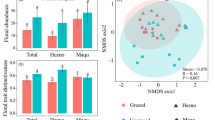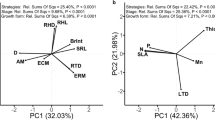Abstract
Increasing atmospheric CO2 concentrations affect the performances of herbivores. Most previous studies have focused on the effects of abrupt increases in CO2 concentration on herbivore performance, but knowledge about the response of herbivores to gradual increases in CO2 is lacking. We tested the hypothesis that herbivores will show different responses to abrupt and gradual CO2 increases. We measured the performance of the brown planthopper (BPH) (Nilaparvata lugens (Stål)) reared on rice for 15 successive generations under three CO2 levels: ambient CO2 (375 µl/L), a gradual increase in CO2 (25 µl/L increase per generation, 390–750 µl/L), and an abrupt increase in CO2 (750 µl/L). During the first generation, the female and male longevities were affected by both the gradual and abrupt increases in CO2, and the fecundity and net reproductive rate (R0) of the BPH in the abruptly increased CO2 treatment were significantly lower than those in the other two treatments; there were no significant differences in the intrinsic rate of increase (r) and the finite rate of increase (λ) among the three CO2 treatments. After 14 generations, female longevity was significantly prolonged in treatments with both gradual and abrupt CO2 increases. The fecundity of the BPHs reared in the gradual CO2 treatment was significantly higher than that in the other two CO2 treatments. According to the population parameters (r, λ, and R0) and population projection, under a gradual increase in CO2, the BPH population size was higher than that under an abrupt CO2 increase. We concluded that the BPH abundance will increase under a gradual CO2 increase and consequently result in an increase in rice yield loss.





Similar content being viewed by others
References
Akca I, Ayvaz T, Yazici E, Smith CL, Chi H (2015) Demography and population projection of Aphis fabae (Hemiptera: Aphididae): with additional comments on life table research criteria. J Econ Entomol 108:1466–1478
Akköprü EP, Atlihan R, Okut H, Chi H (2015) Demographic assessment of plant cultivar resistance to insect pests: a case study of the dusky-veined walnut aphid (Hemiptera: Callaphididae) on five walnut cultivars. J Econ Entomol 108:378–387
Bestete LR, Torres JB, Silva RBB, Silva-Torres CSA, Bastos CS (2016) Development of cotton pests exhibiting different feeding strategy on water-stressed and kaolin-treated cotton plants. J Pest Sci 90(1):1–12
Boullis A, Francis F, Verheggen F (2018) Aphid-hoverfly interactions under elevated CO2 concentrations: oviposition and larval development. Physiol Entomol 43:245–250
Carroll SP, Hendry AP, Reznick DN, Fox CW (2007) Evolution on ecological time-scales. Funct Ecol 21:387–393
Chang X, Han W, Xiao N, Li J, Chen F (2011) Effects of elevated CO2 and transgenic Bt rice on yeast-like endosymbiote and its host brown planthopper. J Appl Entomol 135:333–342
Chen F, Ge F, Su J (2005) An improved top-open chamber for research on the effects of elevated CO2 on agricultural pests in field-improved open-top chamber. Chin J Ecol 5:585–590 (in Chinese)
Chen GM, Chi H, Wang RC, Wang YP, Xu YY, Li XD, Yin P, Zheng FQ (2018) Demography and uncertainty of population growth of Conogethes punctiferalis (Lepidoptera: Crambidae) reared on five host plants with discussion on some life history statistics. J Econ Entomol 111(5):2143–2152
Chi H (1988) Life-table analysis incorporating both sexes and variable development rates among individuals. Environ Entomol 17:26–34
Chi H (1990) Timing of control based on the stage structure of pest populations: a simulation approach. J Econ Entomol 83(4):1143–1150
Chi H (2019a) TWOSEX-MSChart: a computer program for the age-stage, two-sex life table analysis. National Chung Hsing University, Taichung, Taiwan. http://140.120.197.173/Ecology/Download/Twosex-MSChart.zip. Accessed 1 May 2016
Chi H (2019b) TIMING-MSChart: a computer program for the population projection based on age-stage, two-sex life table. National Chung Hsing University, Taichung, Taiwan. http://140.120.197.173/Ecology/Download/Timing-MSChart.zip. Accessed 1 May 2016
Chi H, Liu H (1985) Two new methods for the study of insect population ecology. Bull Inst Zool Acad Sin 24:225–240
Chi H, Su HY (2006) Age-stage, two-sex life tables of Aphidius gifuensis (Ashmead) (Hymenoptera: Braconidae) and its host Myzus persicae (Sulzer) (Homoptera: Aphididae) with mathematical proof of the relationship between female fecundity and the net reproductive rate. Environ Entomol 35:10–21
Dai Y, Wang MF, Jiang SL, Zhang YF, Parajuleec MN, Chen FJ (2018) Host-selection behavior and physiological mechanisms of the cotton aphid, Aphis gossypii, in response to rising atmospheric carbon dioxide levels. J Insect Physiol 109:149–156
Ferreira RB, Moraes JC, Auad AM, Fonseca MG (2013) Interaction of spittlebug and forage grass under different carbon dioxide concentrations. J Pest Sci 86:161–166
Fu JW, Shi MZ, Wang T, Li JY, Zheng LZ, Wu G (2016) Demography and population projection of flea beetle, Agasicles hygrophila (Coleoptera, Chrysomelidae), fed on alligator weed under elevated CO2. J Econ Entomol 109:1116–1124
Ge LQ, Sun YC, Ouyang F, Wu JC, Ge F (2015) The effected of triazophos applied to transgenic Bt rice on the nutritional indexes, Nlvg expression, and population growth of Nilaparvata lugens Stål under elevated CO2. Pest Biochem Phys 118:50–57
Goodman D (1982) Optimal life histories, optimal notation, and the value of reproductive value. Am Nat 119:803–823
Guo HJ, Sun YC, Li YF, Tong B, Harris M, Zhu-Salzman K, Ge F (2013) Pea aphid promotes amino acid metabolism both in Medicago truncatula and bacteriocytes to favor aphid population growth under elevated CO2. Global Change Biol 19:3210–3223
Hentley WT, Vanbergen AJ, Hails RS, Jones TH, Johnson SN (2014) Elevated atmospheric CO2 impairs aphid escape responses to predators and conspecific alarm signals. J Chem Ecol 40:1110–1114
Huang HW, Chi H, Smith CL (2018) Linking demography and consumption of Henosepilachna vigintioctopunctata (Coleoptera: Coccinellidae) fed on Solanum photeinocarpum: with a new method to project the uncertainty of population growth and consumption. J Econ Entomol 111:1–9
IPCC (2004) Impacts, adaptation and vulnerability. In: Field CB, Barros VR, Dokken DJ, Mach KJ, Mastrandrea MD, Bilir TE et al (eds) Working Group II contribution to the fifth assessment report of the intergovernmental panel on climate change, vol 1132. Cambridge University Press, Cambridge
Jiang S, Dai Y, Lu Y, Fan S, Liu Y, Bodlah MA, Parajulee MN, Chen F (2018) Molecular evidence for the fitness of cotton aphid, Aphis gossypii in response to elevated CO2 from the perspective of feeding behavior analysis. Front Physiol 9:1444
Johnson NL, Kotz S, Balakrishman N (1970) Continuous univariate distributions: distributions in statistics, vol I. John Wiley & Sons, New York.
Klironomos JN, Allen MF, Rillig MC, Piotrowski J, Makvandi-Nejad S, Wolfe BE, Powell JR (2005) Abrupt rise in atmospheric CO2 overestimates community response in a model plant–soil system. Nature 433:621–624
Landosky JM, Karowe DN (2014) Will chemical defenses become more effective against specialist herbivores under elevated CO2? Global Change Biol 20:3159–3176
Lewontin RC (1965) Selection for colonizing ability. In: Baker HG, Stebbins GL (eds) The genetic of colonizing species. Academic Press, San Diego, pp 77–94
Liang Y, Hua H, Zhu YG, Zhang J, Cheng C, Romheld V (2006) Importance of plant species and external silicon concentration to active silicon uptake and transport. New Phytol 172:63–72
Liu JP, Huang WK, Wang CH, Hua HX, Wu G (2017) Effect of elevated CO2 on the fitness and potential population damage of Helicoverpa armigera based on two-sex life table. Sci Rep 7:1119
Marcott SA, Bauska TK, Buizert C, Steig EJ, Rosen JL, Cuffey KM, Fudge TJ, Severinghaus JP, Ahn J, Kalk ML, McConnell JR, Sowers T, Taylor KC, White JWC, Brook EJ (2014) Centennial-scale changes in the global carbon cycle during the last deglaciation. Nature 514:616–619
Mou DF, Lee CC, Smith CL, Chi H (2015) Using viable eggs to accurately determine the demographic and predation potential of Harmonia dimidiata (Coleoptera: Coccinellidae). J Appl Entomol 139:579–591
Pinder JE III, Wiener JG, Smith MH (1978) The weibull distribution: a new method of summarizing survivorship data. Ecology 59:175–179
Prasannakumar N, Chander S, Pal M (2012) Assessment of impact of climate change with reference to elevated CO2 on rice brown planthopper, Nilaparvata lugens (Stål) and crop yield. Curr Sci 103:1201–1205
Qian L, He S, Liu X, Huang Z, Chen F, Gui F (2018) Effect of elevated CO2 on the interaction between invasive thrips, Frankliniella occidentalis, and its host kidney bean, Phaseolus vulgaris. Pest Manag Sci. https://doi.org/10.1002/ps.5064
Reich PB, Hobbie SE, Lee TD, Pastore MA (2018) Unexpected reversal of C3 versus C4 grass response to elevated CO2 during a 20-year field experiment. Science 360(6386):317–320
Robinson EA, Ryan GD, Newman JA (2012) A meta-analytical review of the effects of elevated CO2 on plant–arthropod interactions highlights the importance of interacting environmental and biological variables. New Phytol 194:321–336
Shi B, Huang J, Hu C, Hou M (2014) Interactive effects of elevated CO2 and temperature on rice planthopper, Nilaparvata lugens. J Integr Agric 13(7):1520–1529
Shi MZ, Li JY, Ding B, Fu JW, Zheng LZ, Chi H (2019) Indirect effects of elevated CO2 on population parameters and growth of Agasicles hygrophila (Coleoptera: Chrysomelidae), a biocontrol agent of alligatorweed (Amaranthaceae). J Econ Entomol 112(3):1120–1129. https://doi.org/10.1093/jee/toz015
Sun Y, Guo H, Yuan E, Ge F (2018) Elevated CO2 increases R gene-dependent resistance of Medicago truncatula against the pea aphid by up-regulating a heat shock gene. New Phytol 217(4):1697–1711
Sun Y, Guo H, Ge F (2019) Medicago truncatula–pea aphid interaction in the context of global climate change. Model Legume Medicago Truncatula. https://doi.org/10.1002/9781119409144.ch45
Tuan SJ, Yeh CC, Atlihan R, Chi H (2016) Linking life table and predation rate for biological control: a comparative study of Eocanthecona furcellata (Hemiptera: Pentatomidae) fed on Spodoptera litura (Lepidoptera: Noctuidae) and Plutella xylostella (Lepidoptera: Plutellidae). J Econ Entomol 109:13–24
Wang CY, Fei MH, Meng L, Harvey JA, Li BP (2020) Effects of elevated CO2 and temperature on survival and wing dimorphism of two species of rice planthoppers (Hemiptera: Delphacidae) under interaction. Pest Manag Sci 8:8–9. https://doi.org/10.1002/ps.5747
Wen D, Liu JP, Fan S, Zhang ZY, Wu G (2019) Evaluation on the fitness and population projection of Nilaparvata lugens in response to elevated CO2 using two-sex life table. Int J Pest Man. https://doi.org/10.1080/09670874.2019.1654146
Xie H, Liu K, Sun D, Wang Z, Lu X, He K (2015) A field experiment with elevated atmospheric CO2-mediated changes to C4 crop-herbivore interactions. Sci Rep 5:13923
Yan HY, Guo HG, Sun YC, Ge F (2020) Plant phenolics mediated bottom-up effects of elevated CO2 on Acyrthosiphon pisum and its parasitoid Aphidius avenae. Insect Sci 27:170–184
Zhang X, Mao K, Liao X, He B, Jin R, Tang B, Wan H, Li J (2018) Fitness cost of nitenpyram resistance in the brown planthopper Nilaparvata lugens. J Pest Sci 91:1145–1151
Acknowledgements
This research was supported by the National Key R & D Program of China (No. 2017YFD0200400) and the National Genetically Modified Organisms Breeding Major Project (2016ZX08012-005). We thank Yunyun Zeng and Dong Wen for their excellent practical assistance throughout this work.
Author information
Authors and Affiliations
Corresponding author
Ethics declarations
Conflict of interest
All authors declare no conflicts of interest.
Additional information
Communicated by I. Hiltpold.
Publisher's Note
Springer Nature remains neutral with regard to jurisdictional claims in published maps and institutional affiliations.
Rights and permissions
About this article
Cite this article
Liu, J., Zhuang, J., Huang, W. et al. Different adaptability of the brown planthopper, Nilaparvata lugens (Stål), to gradual and abrupt increases in atmospheric CO2. J Pest Sci 93, 979–991 (2020). https://doi.org/10.1007/s10340-020-01221-x
Received:
Revised:
Accepted:
Published:
Issue Date:
DOI: https://doi.org/10.1007/s10340-020-01221-x




